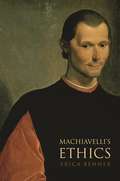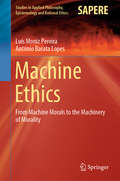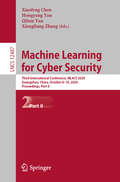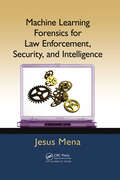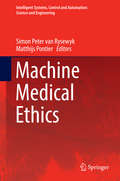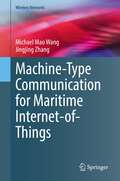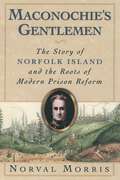- Table View
- List View
M&A Disputes: A Professional Guide to Accounting Arbitrations (Wiley Finance)
by A. Vincent Biemans Gerald M. HansenNavigate M&A accounting arbitrations with insider perspective M&A Disputes takes you inside the dispute resolution process to help you put together the many "moving parts" necessary to obtain a successful outcome. With deep insight from experts in the field—including valuable advice from the arbitrator's perspective—this book guides you through the entire process to explore the variables at work. The high volume of M&A transactions makes post-closing price adjustment provisions and accounting arbitrations a critical part of doing business. Yet, the field is opaque to non-practitioners and important issues can be easily misunderstood without specific knowledge and experience. A resulting award can make or break a transaction; an intimate understanding of the process's inner working can help you plan your position to the greatest advantage. This book explores the many factors that that contribute to a successful resolution across the entire transaction life cycle from contract negotiation through the dispute phase including due diligence, determination of the target net working capital, conception and closing of the purchase agreement, post-closing negotiation and dispute resolution, the impact of accounting practices, guidance, and documentation as well as relevant auditing concepts, and various facts and circumstances surrounding the target business and the transaction that need to be considered. M&A volume remains high and continues to result in large numbers of current and future post-closing M&A disputes. Clients rely on their attorneys and advisers to guide them through the process and counsel them toward a positive outcome. Those professionals will find that M&A accounting arbitrations carry a range of distinctions that require a specialized knowledge base to navigate correctly. This book provides real-world guidance from experts in the field, with invaluable insight for every stage of the process. Walk through the entire dispute resolution process from arbitrator selection through final award Understand how M&A agreement provisions impact the awarded amount as well as the options available to limit the scope of potential disputes and the "gaming" of the post-closing process by the counterparty Understand the nature of accounting estimates and guidance, their interaction with accounting arbitrations, and how to synthesize facts, circumstances, and GAAP into a persuasive argument to present to the accounting arbitrator Get situation-specific advice for different types of transactions Learn practitioner "dos" and "don'ts" from the arbitrator's perspective M&A Disputes provides transaction parties and their representatives an inside view at the transaction and commonly disputed items through the eyes of the arbitrator to provide them with uniquely valuable insight. In addition to being an invaluable tool for practitioners appearing before an accounting arbitrator, M&A Disputes also provides advice to would-be and experienced arbitrators alike to successfully resolve disputes that can be significant and complex.
M&A Disputes: How They Happen, How to Resolve Them, How to Avoid Them
by Heiko Daniel Ziehms<span style="font-size:12.0pt;mso-bidi-font-family: Arial;color:black;mso-ansi-language:EN-GB">M&A disputes, which range from breach of warranty and fraud claims to disagreements over price adjustments, earn-outs, material adverse change clauses and many others – are more common than many participants in M&A transactions may realise. They can take years to resolve and cost many millions of pounds, euros, or dollars. A dispute can adversely affect the post-transaction environment and hence the prospects of a successful acquisition or, at worst, frustrate a deal entirely. It is therefore vital to understand how such disputes happen, how they can be resolved, and how to avoid them, or at least minimise the potential for an M&A dispute. This indispensable practice guide provides not only a comprehensive discussion of the ‘mechanics’ of M&A transactions and purchase price adjustments but also a deeply informed analysis of what goes wrong in deals that leads to disputes and how to avoid (or resolve) such eventualities. <span style="font-size:12.0pt;color:black; mso-ansi-language:EN-GB">Originally <span style="font-size: 12.0pt;mso-bidi-font-family:Arial;color:black;mso-ansi-language:EN-GB">intended as a second edition of the author’s well-known M&A Disputes and Completion Mechanisms, published in 2018, this is in fact<span style="font-size:12.0pt;mso-bidi-font-family:Arial;color:black; mso-ansi-language:EN-GB"> a new book, drawing on a new set of experiences and observations taken from a period where the scope for M&A disputes has intensified. Framed as an in-depth discussion of typical questions that confront those who assess financial and accounting issues in M&A disputes, including the question of damages, the analysis expertly investigates the pitfalls that can arise in such components of the process as the following: <span style="font-size:12.0pt; color:black;mso-ansi-language:EN-GB">the completion mechanism, including the rationale and basis of measurement of individual purchase price adjustments and the locked box; <span style="font-size:12.0pt; color:black;mso-ansi-language:EN-GB">the role of accounting information in presenting, or misrepresenting, the underlying economic reality of a business and in informing a valuation; <span style="font-size:12.0pt; color:black;mso-ansi-language:EN-GB">valuation principles, standards of value, and valuation methods used for M&A disputes; <span style="font-size:12.0pt; color:black;mso-ansi-language:EN-GB">valuation matters specific to M&A disputes, including the question of value vs. price and the choice of counterfactuals; <span style="font-size:12.0pt; color:black;mso-ansi-language:EN-GB">material adverse change clauses; and <span style="font-size:12.0pt; color:black;mso-ansi-language:EN-GB">‘red flags’ for fraud. <span style="font-size:12.0pt;color:black; mso-ansi-language:EN-GB">A concluding chapter distils ‘lessons learned’ into a short, practical commentary drawing on the author’s extensive experience of M&A- and related disputes, with recommendations that plot a clear path to avoidance of disputes. With its sound understanding of the completion mechanism, including an extensive discussion of measurement of individual purchase price adjustments, the locked box, and how to identify fraud, this practical and up-to-date guide, grounded in corporate finance theory, will be a valuable resource to all those who work on M&A transactions, whether as principal, adviser, insurer, funder, independent expert, judge, or arbitrator..
M&A Disputes and Completion Mechanisms (Arbitration in Context Series)
by Heiko Daniel ZiehmsIn the course of a merger and acquisition (M&A) transaction, the principals and their advisors face a series of decisions, often against the backdrop of an unrealistic deadline, imperfect information and a shrewd other side. In making these decisions, they have to deal with complex technical matters at the intersection of disciplines, including accounting, law, taxation, corporate finance, operations, environmental and strategy. It is not always possible during the negotiations to take a step back and contemplate issues likely to arise before or after completion that may result in a dispute or to address or mitigate risks. It is therefore easy in these highly charged circumstances to create outcomes that end up in legal disputes. A sound understanding of the completion mechanism including the basis and measurement of individual purchase price adjustments is important to negotiate good deals and avoid disputes. This book provides an in-depth discussion of the completion mechanism, including key arguments for or against individual deductions or adjustments. This can be helpful in negotiations. It also provides diagnostic tools and many recommendations that can help avoid disputes. If a dispute has occurred, it discusses how it can be resolved as well as the conceptual basis and practical approaches to the measurement of damages. The book deals with numerous matters that need to be addressed during M&A negotiations and can lead to post-M&A dissonance, including the following: - the equity bridge: from fi rm value to the purchase price for the equity; - closing conditions, the closing process and the completion accounts; - an in-depth discussion of individual purchase price adjustments from factoring to pensions and from leases to the working capital reference value; - material adverse change clauses; - aspects of locked box transactions, including the interest over the locked box period; - how to structure earn-outs to avoid disputes; - red flags for fraud; - damages valuation in M&A disputes; and - lessons learned on how to avoid or deal with disputes. The author analyses a large number of actual post-M&A disputes as a lens to bring into focus precisely where things go wrong in practice. He then sets out practical solutions to the problems dealmakers face, how to negotiate individual price adjustments, and lessons learned from disputes. This book will be useful to M&A practitioners, be they in-house counsel, private equity, sovereign wealth funds, international arbitration centres or other players, as well as the investment bankers, accountants and the professionals who advise them. It will also prove to be of great value to those who deal with post-M&A disputes – judges, arbitrators and litigators – and legal academics interested in the M&A field.
The Macabresque: Human Violation and Hate in Genocide, Mass Atrocity and Enemy-Making
by Edward WeisbandStudies of genocide and mass atrocity most often focus on their causes and consequences, their aims and effects, and the number of people killed. But the question remains, if the main goal is death, then why is torture necessary? This book argues that genocide and mass atrocity are committed not as an end in themselves but as a means to pursue sustained and systemic torture -- the spectacle of violence -- against its victims. Extermination is not the only, or even the primary, goal of genocidal campaigns. In The Macabresque, Edward Weisband looks at different episodes of mass violence (Chinese Cultural Revolution, the Holocaust, post-Ottoman Turkey, Cambodia, Rwanda, and Bosnia, among other instances) to consider why different methods of violence were used in each and how they related to the particular cultural milieu in which they were perpetrated. He asserts that it is not accidental that certain images capture our memory as emblematic of specific genocides or mass atrocities (the death marches of the Armenian genocide, mass starvation in the Ukraine, the killing apparatus and laboratories of the Holocaust, the killing fields of Cambodia) because such violence assumes a kind of style each time and place it arises. Weisband looks at these variations in terms of their aesthetic or dramaturgical style, or what he calls the macabresque. The macabresque is ever present in genocide and mass atrocity across time, place and episode. Beyond the horrors of lethality, it is the defining feature of concentration and/or death camps, detention centers, prisons, ghettos, killing fields, and the houses, schools and hospitals converted into hubs for torture. Macabresque dramaturgy also assumes many aesthetic forms, all designed to inflict hideous pain and humiliating punishments, sometimes in controlled environments, but also during frenzied moments of staged public horror. These kinds of performative violations permit perpetrators to revel in their absolute power but simultaneously to project hatred, revenge and revulsion onto victims, who embody the shame, humiliation and loss felt by their torturers. By understanding how and why mass violence occurs and the reasons for its variations, The Macabresque aims to explain why so many seemingly normal or "ordinary" people participate in mass atrocity across cultures and why such egregious violence occurs repeatedly through history.
The Macabresque: Human Violation and Hate in Genocide, Mass Atrocity and Enemy-Making
by Edward WeisbandStudies of genocide and mass atrocity most often focus on their causes and consequences, their aims and effects, and the number of people killed. But the question remains, if the main goal is death, then why is torture necessary? This book argues that genocide and mass atrocity are committed not as an end in themselves but as a means to pursue sustained and systemic torture -- the spectacle of violence -- against its victims. Extermination is not the only, or even the primary, goal of genocidal campaigns. In The Macabresque, Edward Weisband looks at different episodes of mass violence (Chinese Cultural Revolution, the Holocaust, post-Ottoman Turkey, Cambodia, Rwanda, and Bosnia, among other instances) to consider why different methods of violence were used in each and how they related to the particular cultural milieu in which they were perpetrated. He asserts that it is not accidental that certain images capture our memory as emblematic of specific genocides or mass atrocities (the death marches of the Armenian genocide, mass starvation in the Ukraine, the killing apparatus and laboratories of the Holocaust, the killing fields of Cambodia) because such violence assumes a kind of style each time and place it arises. Weisband looks at these variations in terms of their aesthetic or dramaturgical style, or what he calls the macabresque. The macabresque is ever present in genocide and mass atrocity across time, place and episode. Beyond the horrors of lethality, it is the defining feature of concentration and/or death camps, detention centers, prisons, ghettos, killing fields, and the houses, schools and hospitals converted into hubs for torture. Macabresque dramaturgy also assumes many aesthetic forms, all designed to inflict hideous pain and humiliating punishments, sometimes in controlled environments, but also during frenzied moments of staged public horror. These kinds of performative violations permit perpetrators to revel in their absolute power but simultaneously to project hatred, revenge and revulsion onto victims, who embody the shame, humiliation and loss felt by their torturers. By understanding how and why mass violence occurs and the reasons for its variations, The Macabresque aims to explain why so many seemingly normal or "ordinary" people participate in mass atrocity across cultures and why such egregious violence occurs repeatedly through history.
MacCormick's Scotland (Edinburgh Studies in Law)
by Neil WalkerThis book analyses in depth the distinctively Scottish themes in the work of Sir Neil MacCormick, the world-renowned legal philosopher and prominent Scottish public intellectual who died in 2009 after holding the Regius Chair in Public Law and the Law of Nature and Nations at Edinburgh University for 36 years. MacCormick's work, and works about MacCormick, attract both a domestic and an international audience. Readers will gain an understanding of how MacCormick's Scottish roots, interests and commitments coloured his work - both his distinctively Scottish writings and the overall intellectual outlook that informed his broader legal and philosophical writings.The book provides a well rounded appreciation of the Scottish dimension in MacCormick's thinking and writing. It focuses on a number of prominent Scottish themes in MacCormick's work and life and is structured around four key themes: 1) the nature and identity of a legal system; 2) sovereignty, European integration and Scottish independence; 3) the legacy of the legal and political thought of the Scottish enlightenment; and 4) the role of the academic in the Scottish public sphere.Key Features:* Edited by Neil Walker - a highly respected scholar and thinker, and a prolific writer who has edited many excellent collections of essays.* The editor succeeded MacCormick in the Regius Chair and all of the contributors are closely acquainted with MacCormick the man and the scholar.* The first book to examine MacCormick through a distinctly Scottish lens.
MacCormick's Scotland (Edinburgh Studies in Law)
by Neil WalkerA Gedenkschrift to one of Scotland's most prominent jurists and legal thinkers.
Macdonald on the Law of Freedom of Information
by John Macdonald QC and Ross CrailTen years after the Freedom of Information Act 2000 came into force in the UK, the implementation and case law related to the Act remains contentious. This new edition of the standard practitioners' text provides a complete, authoritative, and accessible guide to this challenging and rapidly evolving area of law. The core of the book is a full and lucid exploration of the statutory scheme: the Act itself, as well as the Environmental Regulations 2004 and the Data Protections Act 1998. It provides historical perspectives, aids to construction, and in-depth analysis of all provisions, with discussion expanded to include the problems exposed by the mass of information about individuals now available on the internet, and the best way to protect citizens from those who commit crimes and torts online. Further chapters address how the Act relates to other legal issues, including human rights, confidentiality, data protection, and official secrets. Finally, it offers an account of the different ways the disclosure of information is treated in the European Union and the devolved parts of the UK, and a comparative survey of information rights in other parts of the world.
Macdonald on the Law of Freedom of Information
Ten years after the Freedom of Information Act 2000 came into force in the UK, the implementation and case law related to the Act remains contentious. This new edition of the standard practitioners' text provides a complete, authoritative, and accessible guide to this challenging and rapidly evolving area of law. The core of the book is a full and lucid exploration of the statutory scheme: the Act itself, as well as the Environmental Regulations 2004 and the Data Protections Act 1998. It provides historical perspectives, aids to construction, and in-depth analysis of all provisions, with discussion expanded to include the problems exposed by the mass of information about individuals now available on the internet, and the best way to protect citizens from those who commit crimes and torts online. Further chapters address how the Act relates to other legal issues, including human rights, confidentiality, data protection, and official secrets. Finally, it offers an account of the different ways the disclosure of information is treated in the European Union and the devolved parts of the UK, and a comparative survey of information rights in other parts of the world.
Macdonald's Exemption Clauses and Unfair Terms
by Mark Anderson Victor WarnerAn updated guide, and expert analysis on, the legal issues relating to common exemption clauses and unfair terms in legal contracts. It covers the incorporation and construction of the key clauses, as well as the relevant legislation. It will help you to understand:- the circumstances when a term will be incorporated into a contract- the modern approach to the interpretation of contracts by the contracts (and with particular types of clauses, for example in relation to negligence, entire agreement clauses, 'fundamental breach', etc)- clause by clause consideration of UCTA, including key concepts such as the meaning of the 'requirement for reasonableness' - clause by clause consideration of the unfair term provisions of the Consumer Rights Act 2015, and with paragraph by paragraph consideration of the potentially unfair terms in Schedule to the ActThis edition includes coverage of:- Analysis of how the courts now interpret exclusion and liability clauses and other contract clauses, e.g.: --- after the decisions of the Supreme Court in Wood v Capita Insurance Services Ltd, and Rainy Sky SA and others v Kookmin Bank --- the treatment of 'stringent' exemption clauses, in the decision of Goodlife Foods Ltd V Hall Fire Protection Ltd --- the requirement for clear wording, such as where parties wish to avoid liability for non-fraudulent, pre-contract (mis)representations, e.g. in the decisions in AXA Sun Life Services pc v Campbell Martin Ltd and BSkyB Ltd v HP Enterprise Services UK Ltd -Coverage of the changes brought about by the Consumer Rights Act 2015, including: --- recent case law considering the effect and interpretation of unfair terms, particularly concerning the 'core' exemption, in the decisions of OFT v Abbey National plc and the later ECJ cases of Kásler and Mattei --- consideration of the list of potentially unfair terms found in Schedule 2 to the Act and the CMA analysis of them Legislation covered includes:- Consumer Rights Act 2015- Unfair Contract Terms Act 1977- Contracts (Rights of Third Parties) Act 1999- Misrepresentation Act 1967
Machiavelli's Ethics
by Erica BennerMachiavelli's Ethics challenges the most entrenched understandings of Machiavelli, arguing that he was a moral and political philosopher who consistently favored the rule of law over that of men, that he had a coherent theory of justice, and that he did not defend the "Machiavellian" maxim that the ends justify the means. By carefully reconstructing the principled foundations of his political theory, Erica Benner gives the most complete account yet of Machiavelli's thought. She argues that his difficult and puzzling style of writing owes far more to ancient Greek sources than is usually recognized, as does his chief aim: to teach readers not how to produce deceptive political appearances and rhetoric, but how to see through them. Drawing on a close reading of Greek authors--including Thucydides, Xenophon, Plato, and Plutarch--Benner identifies a powerful and neglected key to understanding Machiavelli. This important new interpretation is based on the most comprehensive study of Machiavelli's writings to date, including a detailed examination of all of his major works: The Prince, The Discourses, The Art of War, and Florentine Histories. It helps explain why readers such as Bacon and Rousseau could see Machiavelli as a fellow moral philosopher, and how they could view The Prince as an ethical and republican text. By identifying a rigorous structure of principles behind Machiavelli's historical examples, the book should also open up fresh debates about his relationship to later philosophers, including Rousseau, Hobbes, and Kant.
Machiavelli's Ethics
by Erica BennerMachiavelli's Ethics challenges the most entrenched understandings of Machiavelli, arguing that he was a moral and political philosopher who consistently favored the rule of law over that of men, that he had a coherent theory of justice, and that he did not defend the "Machiavellian" maxim that the ends justify the means. By carefully reconstructing the principled foundations of his political theory, Erica Benner gives the most complete account yet of Machiavelli's thought. She argues that his difficult and puzzling style of writing owes far more to ancient Greek sources than is usually recognized, as does his chief aim: to teach readers not how to produce deceptive political appearances and rhetoric, but how to see through them. Drawing on a close reading of Greek authors--including Thucydides, Xenophon, Plato, and Plutarch--Benner identifies a powerful and neglected key to understanding Machiavelli. This important new interpretation is based on the most comprehensive study of Machiavelli's writings to date, including a detailed examination of all of his major works: The Prince, The Discourses, The Art of War, and Florentine Histories. It helps explain why readers such as Bacon and Rousseau could see Machiavelli as a fellow moral philosopher, and how they could view The Prince as an ethical and republican text. By identifying a rigorous structure of principles behind Machiavelli's historical examples, the book should also open up fresh debates about his relationship to later philosophers, including Rousseau, Hobbes, and Kant.
Machine Ethics: From Machine Morals to the Machinery of Morality (Studies in Applied Philosophy, Epistemology and Rational Ethics #53)
by Luís Moniz Pereira António Barata LopesThis book offers the first systematic guide to machine ethics, bridging between computer science, social sciences and philosophy. Based on a dialogue between an AI scientist and a novelist philosopher, the book discusses important findings on which moral values machines can be taught and how. In turn, it investigates what kind of artificial intelligence (AI) people do actually want. What are the main consequences of the integration of AI in people’s every-day life? In order to co-exist and collaborate with humans, machines need morality, but which moral values should we teach them? Moreover, how can we implement benevolent AI? These are just some of the questions carefully examined in the book, which offers a comprehensive account of ethical issues concerning AI, on the one hand, and a timely snapshot of the power and potential benefits of this technology on the other. Starting with an introduction to common-sense ethical principles, the book then guides the reader, helping them develop and understand more complex ethical concerns and placing them in a larger, technological context. The book makes these topics accessible to a non-expert audience, while also offering alternative reading pathways to inspire more specialized readers.
Machine Learning for Cyber Security: Third International Conference, ML4CS 2020, Guangzhou, China, October 8–10, 2020, Proceedings, Part II (Lecture Notes in Computer Science #12487)
by Xiaofeng Chen Hongyang Yan Qiben Yan Xiangliang ZhangThis three volume book set constitutes the proceedings of the Third International Conference on Machine Learning for Cyber Security, ML4CS 2020, held in Xi’an, China in October 2020.The 118 full papers and 40 short papers presented were carefully reviewed and selected from 360 submissions. The papers offer a wide range of the following subjects: Machine learning, security, privacy-preserving, cyber security, Adversarial machine Learning, Malware detection and analysis, Data mining, and Artificial Intelligence.
Machine Learning Forensics for Law Enforcement, Security, and Intelligence
by Jesus MenaIncreasingly, crimes and fraud are digital in nature, occurring at breakneck speed and encompassing large volumes of data. To combat this unlawful activity, knowledge about the use of machine learning technology and software is critical. Machine Learning Forensics for Law Enforcement, Security, and Intelligence integrates an assortment of deductive
Machine Learning Forensics for Law Enforcement, Security, and Intelligence
by Jesus MenaIncreasingly, crimes and fraud are digital in nature, occurring at breakneck speed and encompassing large volumes of data. To combat this unlawful activity, knowledge about the use of machine learning technology and software is critical. Machine Learning Forensics for Law Enforcement, Security, and Intelligence integrates an assortment of deductive
Machine Medical Ethics (Intelligent Systems, Control and Automation: Science and Engineering #74)
by Simon Peter van Rysewyk Matthijs PontierThe essays in this book, written by researchers from both humanities and science, describe various theoretical and experimental approaches to adding medical ethics to a machine, what design features are necessary in order to achieve this, philosophical and practical questions concerning justice, rights, decision-making and responsibility in medical contexts, and accurately modeling essential physician-machine-patient relationships.In medical settings, machines are in close proximity with human beings: with patients who are in vulnerable states of health, who have disabilities of various kinds, with the very young or very old and with medical professionals. Machines in these contexts are undertaking important medical tasks that require emotional sensitivity, knowledge of medical codes, human dignity and privacy.As machine technology advances, ethical concerns become more urgent: should medical machines be programmed to follow a code of medical ethics? What theory or theories should constrain medical machine conduct? What design features are required? Should machines share responsibility with humans for the ethical consequences of medical actions? How ought clinical relationships involving machines to be modeled? Is a capacity for empathy and emotion detection necessary? What about consciousness?This collection is the first book that addresses these 21st-century concerns.
Machine-Type Communication for Maritime Internet-of-Things: From Concept to Practice (Wireless Networks)
by Michael Mao Wang Jingjing ZhangThis book introduces the concept of machine-type communication (MTC) for maritime Internet of Things. The first part of the book portrays a maritime MTC system from an architectural perspective and describes an MTC framework and the fundamental components, laying out a foundation that leads to an ultimate solution to the maritime IoT requirements and challenges. The second part ties together all discussed in the first part and demonstrates how to apply it to a practical system through a realistic design example based on an international maritime mobile spectrum. The book serves as a comprehensive tutorial of the maritime MTC from the top (the network architecture) to the bottom (the air/radio interface and regulatory radio spectrum constraints), guiding readers to an easier understanding of the maritime MTC-related issues and the rationale behind the design. The primary readers of this book include maritime communication engineers, maritime IoT professionals, maritime academia, and the general MTC and IoT communities.Presents the concept of machine-type communication (MTC) for maritime Internet of Things (IoT) and its services, requirements, and challenges;Explains space-earth-integrated maritime machine-type communication system architecture with a comparison with its land counterpart;Sets out a comprehensive framework and details the ways to implement it on a practical radio spectrum;Includes maritime MTC radio spectrum and regulations, network design, protocol design, and air interface design.
The Machinery of Criminal Justice
by Stephanos BibasTwo centuries ago, American criminal justice was run primarily by laymen. Jury trials passed moral judgment on crimes, vindicated victims and innocent defendants, and denounced the guilty. But since then, lawyers have gradually taken over the process, silencing victims and defendants and, in many cases, substituting plea bargaining for the voice of the jury. The public sees little of how this assembly-line justice works, and victims and defendants have largely lost their day in court. As a result, victims rarely hear defendants express remorse and apologize, and defendants rarely receive forgiveness. This lawyerized machinery has purchased efficient, speedy processing of many cases at the price of sacrificing softer values, such as reforming defendants and healing wounded victims and relationships. In other words, the U.S. legal system has bought quantity at the price of quality, without recognizing either the trade-off or the great gulf separating lawyers' and laymen's incentives, values, and powers. In The Machinery of Criminal Justice, author Stephanos Bibas surveys the developments over the last two centuries, considers what we have lost in our quest for efficient punishment, and suggests ways to include victims, defendants, and the public once again. Ideas range from requiring convicts to work or serve in the military, to moving power from prosecutors to restorative sentencing juries. Bibas argues that doing so might cost more, but it would better serve criminal procedure's interests in denouncing crime, vindicating victims, reforming wrongdoers, and healing the relationships torn by crime.
The Machinery of Criminal Justice
by Stephanos BibasTwo centuries ago, American criminal justice was run primarily by laymen. Jury trials passed moral judgment on crimes, vindicated victims and innocent defendants, and denounced the guilty. But since then, lawyers have gradually taken over the process, silencing victims and defendants and, in many cases, substituting plea bargaining for the voice of the jury. The public sees little of how this assembly-line justice works, and victims and defendants have largely lost their day in court. As a result, victims rarely hear defendants express remorse and apologize, and defendants rarely receive forgiveness. This lawyerized machinery has purchased efficient, speedy processing of many cases at the price of sacrificing softer values, such as reforming defendants and healing wounded victims and relationships. In other words, the U.S. legal system has bought quantity at the price of quality, without recognizing either the trade-off or the great gulf separating lawyers' and laymen's incentives, values, and powers. In The Machinery of Criminal Justice, author Stephanos Bibas surveys the developments over the last two centuries, considers what we have lost in our quest for efficient punishment, and suggests ways to include victims, defendants, and the public once again. Ideas range from requiring convicts to work or serve in the military, to moving power from prosecutors to restorative sentencing juries. Bibas argues that doing so might cost more, but it would better serve criminal procedure's interests in denouncing crime, vindicating victims, reforming wrongdoers, and healing the relationships torn by crime.
The Machinery of Government: Public Administration and the Liberal State
by Joseph HeathIn political theory, the traditional model of state power was that elected officials make policy decisions which are then faithfully executed by a lower cadre of public servants. The complexity of the modern state, however, leaves this model outdated. The vast number of economic and social problems it confronts is such that a great deal of rule-making power is now delegated to a class of civil servants. Yet many political philosophers have not taken this model up, and the field has ignored the important role played by the class of "permanent" state officials--the "deep state" as some call it--in liberal states. In most liberal democracies for example, the central bank is as independent as the supreme court, yet deals with a wide range of economic, social, and political issues. How do these public servants make these policy decisions? What normative principles inform their judgments? In The Machinery of Government, Joseph Heath attempts to answer these questions. He looks to the actual practice of public administration to see how normative questions are addressed. More broadly, he attempts to provide the outlines of a "philosophy of the executive" by taking seriously the claim to political authority of the most neglected of the three branches of the state. Heath both provides a corrective to the prevailing tendency to underestimate the contribution of civil servants to the success of liberal-democratic welfare states, and suggests a more satisfactory account of the principles implicit in public administration.
The Machinery of Government: Public Administration and the Liberal State
by Joseph HeathIn political theory, the traditional model of state power was that elected officials make policy decisions which are then faithfully executed by a lower cadre of public servants. The complexity of the modern state, however, leaves this model outdated. The vast number of economic and social problems it confronts is such that a great deal of rule-making power is now delegated to a class of civil servants. Yet many political philosophers have not taken this model up, and the field has ignored the important role played by the class of "permanent" state officials--the "deep state" as some call it--in liberal states. In most liberal democracies for example, the central bank is as independent as the supreme court, yet deals with a wide range of economic, social, and political issues. How do these public servants make these policy decisions? What normative principles inform their judgments? In The Machinery of Government, Joseph Heath attempts to answer these questions. He looks to the actual practice of public administration to see how normative questions are addressed. More broadly, he attempts to provide the outlines of a "philosophy of the executive" by taking seriously the claim to political authority of the most neglected of the three branches of the state. Heath both provides a corrective to the prevailing tendency to underestimate the contribution of civil servants to the success of liberal-democratic welfare states, and suggests a more satisfactory account of the principles implicit in public administration.
Maconochie's Gentlemen: The Story of Norfolk Island and the Roots of Modern Prison Reform (Studies in Crime and Public Policy)
by Norval MorrisIn 1840, Alexander Maconochie, a privileged retired naval captain, became at his own request superintendent of two thousand twice-convicted prisoners on Norfolk Island, a thousand miles off the coast of Australia. In four years, Maconochie transformed what was one of the most brutal convict settlements in history into a controlled, stable, and productive environment that achieved such success that upon release his prisoners came to be called "Maconochie's Gentlemen". Here Norval Morris, one of our most renowned criminologists, offers a highly inventive and engaging account of this early pioneer in penal reform, enhancing Maconochie's life story with a trenchant policy twist. Maconochie's life and efforts on Norfolk Island, Morris shows, provide a model with profound relevance to the running of correctional institutions today. Using a unique combination of fictionalized history and critical commentary, Morris gives this work a powerful policy impact lacking in most standard academic accounts. In an era of "mass incarceration" that rivals that of the settlement of Australia, Morris injects the question of humane treatment back into the debate over prison reform. Maconochie and his "Marks system" played an influential role in the development of prisons; but for the last thirty years prison reform has been dominated by punitive and retributive sentiments, the conventional wisdom holding that we need 'supermax' prisons to control the 'worst of the worst' in solitary and harsh conditions. Norval Morris argues to the contrary, holding up the example of Alexander Maconochie as a clear-cut alternative to the "living hell" of prison systems today.
MacQueen and Thomson Contract Law in Scotland
by Hector L MacQueenProvides a comprehensive introduction to the principles of the Scots law of contract and provides the reader with a clear analysis of this difficult area of the law. This practical text:- Illustrates the different types of contractual situations and examines the formation, performance and enforcement of contracts; - Includes examples of typical contract clauses and treats remedies in detail; - Is set in a comparative context and discusses the problems of cross-border and international contracts; - Explains the underlying principles of contract law;- Is written in a clear, well structured style and uses diagrams to illustrate complex situations. The fifth edition covers key Supreme Court cases including Cavendish Square Holding BV v Tala El Makdessi and ParkingEye Limited v Beavis regarding penalty clauses. It also includes a new chapter on capacity to make a contract ie 'Who can make a Contract?'








